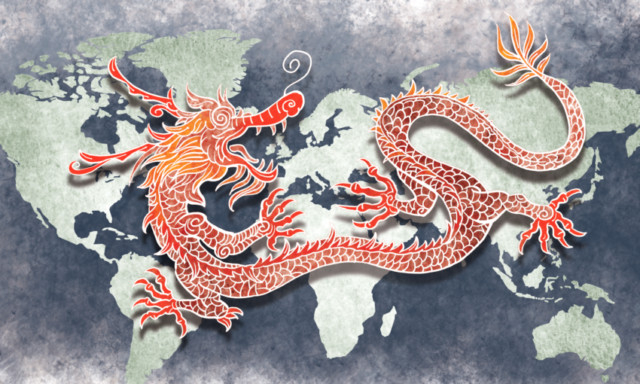
Is China, under its new President, Xi Jinping, undertaking its own diplomatic pivot, parallel to the US’ “pivot to Asia”? Xi’s first significant international initiatives — making Russia his first official visit abroad, followed immediately by his attendance at the Brics summit in South Africa — suggest that China may be seeking to place its relations with the world’s most powerful emerging countries on a par with its US diplomacy. Indeed, this possibility is supported by Xi’s recent statement about relations with India, which he termed “one of the most important bilateral relationships” for China.
Xi’s early focus on Sino-Indian relations is unusual for a Chinese leader. He enunciated a five-point platform, rather like Jawaharlal Nehru’s “five principles of peaceful coexistence,” implemented in the two countries’ Panchsheel Treaty of 1954.
According to Xi’s platform, pending a final settlement of territorial issues, the two countries should cooperate to maintain peace and tranquillity and prevent border disputes from affecting the overall relationship. China and India should maintain close strategic communications in order to keep bilateral relations on the “right track”.
Moreover, the two countries should harness each other’s comparative strengths and expand mutually beneficial cooperation in infrastructure, investment and other areas; strengthen cultural ties to advance an expanding friendship and enhance their cooperation in multilateral forums to safeguard the legitimate rights and interests of developing countries in tackling global challenges. Finally, they should accommodate each other’s core concerns.
While Xi has been preoccupied with his country’s domestic challenges since becoming the Chinese Communist Party (CCP) general-secretary last November, and now as president since March, relations with India can have a direct impact on internal conditions. For example, China’s desire to prevent drug trafficking in its southern province of Yunnan means that its police and security forces are taking a keen interest in what happens in Myanmar, a country that is also of special interest to India.
Then, of course, there is Tibet, perhaps China’s greatest domestic security concern, and also a perennial source of tension with India, owing to territorial disputes. China’s recent anger over a visit by the Dalai Lama to the Tawang monastery in Arunachal Pradesh in India suggests just how potent this issue remains. Hu Shisheng, a leading South Asia strategic analyst at the China Institute for Contemporary International Relations, has suggested that such visits do not mean that “India-China relations are [in a state of] disturbance,” though the potential for trouble remains high.
Under Xi, however, China seems to be accentuating the positive. The CCP’s official newspaper, the People’s Daily, recently identified the “two areas of interest with India” that matter most. With the border issue “effectively controlled,” there should be greater focus on “trade and multilateral issues,” where success can bring about a “new” and welcome “chapter” in bilateral ties.
So is “mistrust” between the two powers diminishing? The People’s Daily seems to consider bilateral relations as normal at this point. India appears to be equally hopeful. Indeed, a senior Indian official, speaking about tensions in the South China Sea, was recently quoted as saying: “You can’t assume that India-China maritime rivalry is inevitable.”
The “Indo-Pacific is one geopolitical area,” the official reportedly said, “but look at the situation in the Indian Ocean. The situation near China, whether in the East China Sea, near Japan, or in the West Pacific, is completely different. India, China and the US — everyone needs sea links; everybody’s energy goes through it.”
A classified report from India’s defence ministry, however, emphasises the “increasing number of Chinese submarines venturing into the Indian Ocean region, thus posing [risks] to India’s security interests.” The report indicated that at least “22 contacts were recorded with vessels suspected to be Chinese attack submarines patrolling outside Beijing’s territorial waters last year,” and warned that the “implicit focus” of China’s navy appears to be “to control highly sensitive sea lines of communication.”
Xi’s efforts to cement ties with China’s other huge neighbour, Russia, should be seen as complementing his outreach to India. Here, Xi has been aided by Russian President Vladimir Putin’s evident disdain for the US and the West. China shares Russia’s suspicions in this regard; indeed, Xi proclaimed that, in terms of geopolitics, Russia and China “speak a common language”.
There are, of course, perfectly legitimate reasons for close Sino-Russian relations. They are partners in the Shanghai Cooperation Organisation. China is the world’s largest energy consumer, while Russia is the biggest energy provider. And bilateral trade is booming, worth $88 billion (Dh323.66 billion) per year.
Xi’s own regional pivot should be viewed as part of his grand vision of a “revitalisation of the Chinese nation,” which essentially calls for China to resume the paramount leadership in Asia that it has exercised for much of its history. His ambitions are vast, yet he, and the Chinese people, appear determined to achieve them. That is far more than can be said of India’s rather woolly strategic meanderings.
— Project Syndicate, 2013
Jaswant Singh, a former Indian finance minister, foreign minister, and defence minister, is the author of Jinnah: India – Partition – Independence.











